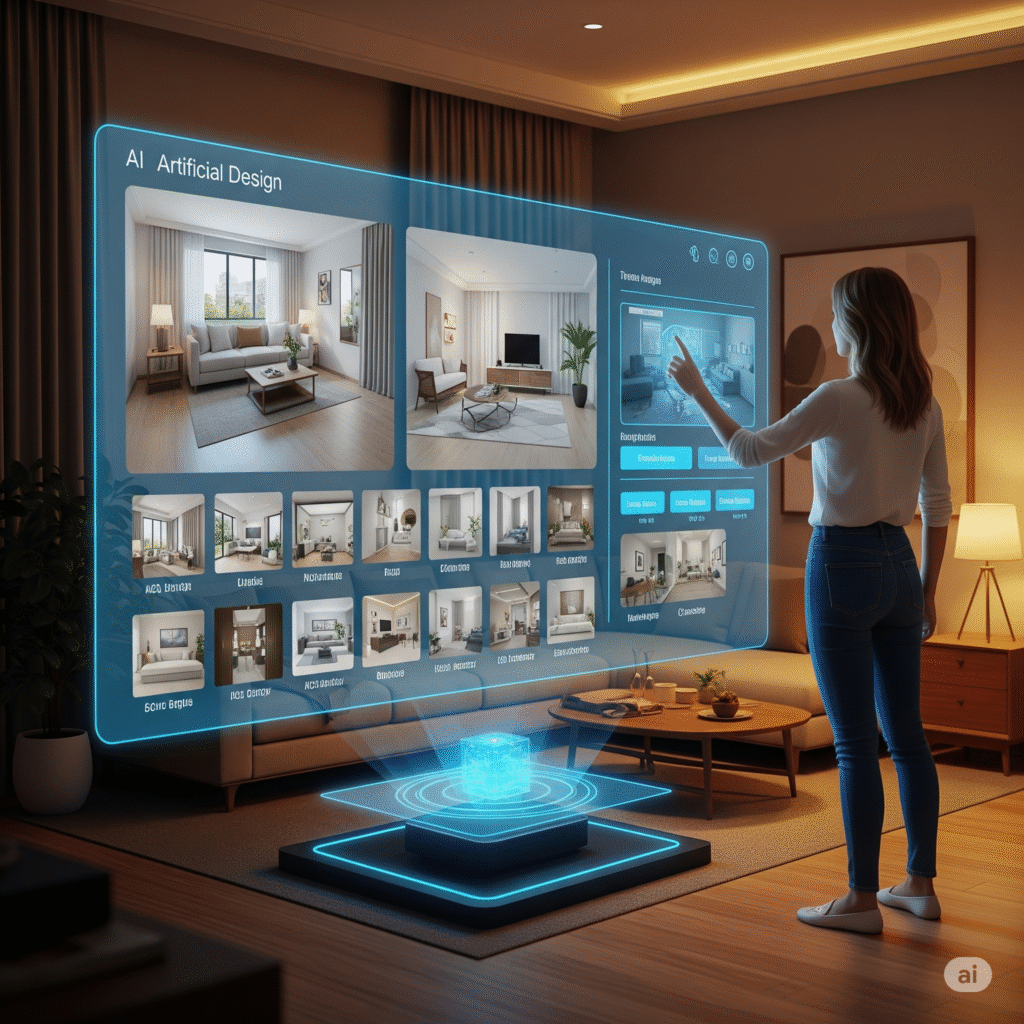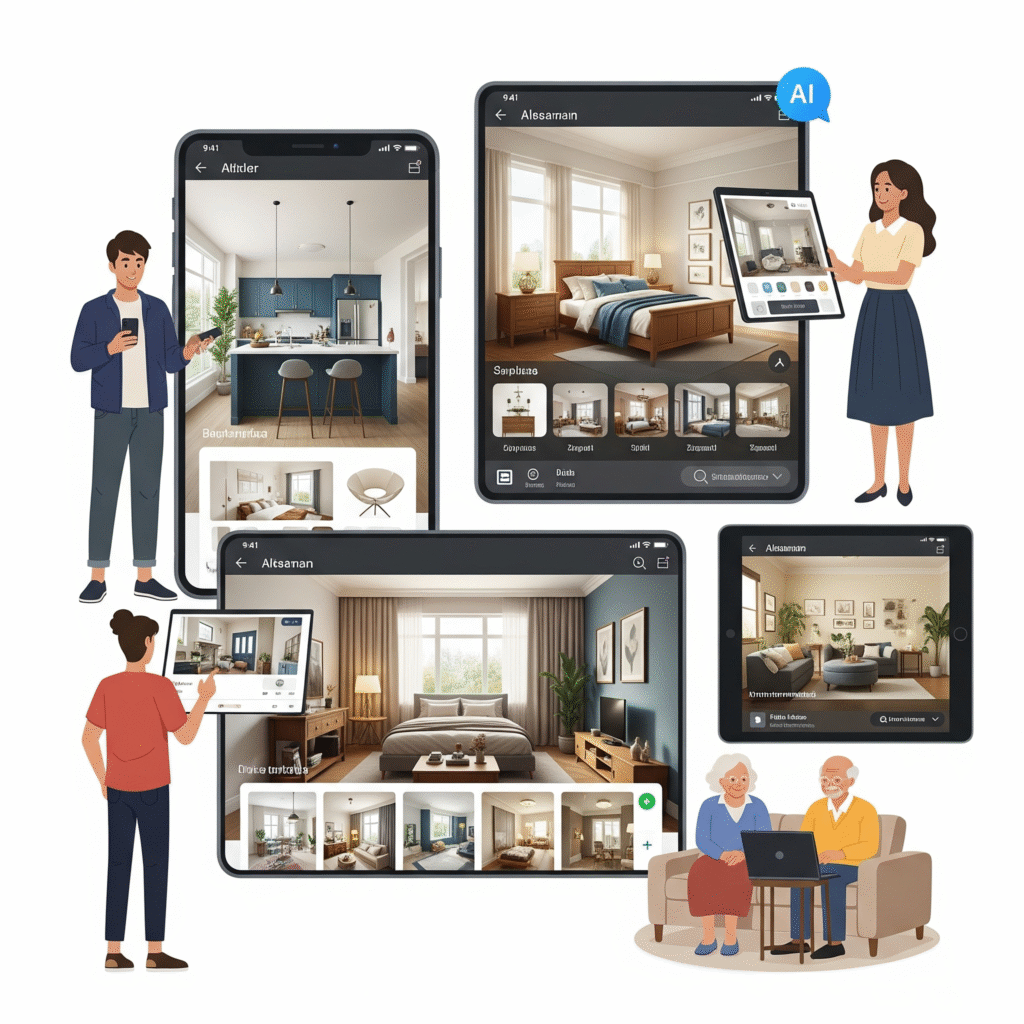The Dawn of a Design Revolution
Imagine standing in the middle of an empty room, its bare walls echoing with possibilities. You envision a cozy, modern living space, but the path from blank canvas to breathtaking design feels overwhelming. The colors, the textures, the furniture—where do you even begin? Once, this journey required endless hours of research, expensive consultations, or a leap of faith in your own instincts. But now, a new era has dawned. Artificial Intelligence (AI) is rewriting the rules of interior design, turning dreams into reality with a few clicks. This is no ordinary story—it’s a dramatic tale of how technology is empowering homeowners, designers, and dreamers to craft spaces that inspire awe.
In this blog, I’ll take you through the world of AI-powered websites and apps that are revolutionizing interior design. We’ll explore real-world case studies, practical steps to transform your home, and expert tips to ensure your designs are not only stunning but also optimized for search engines, adhering to Google’s E-E-A-T (Experience, Expertise, Authoritativeness, Trustworthiness) guidelines. Let’s embark on this journey to reimagine your home, one AI-generated idea at a time.

Why AI is the Key to Unlocking Stunning Interiors
The world of interior design was once a fortress guarded by professionals with years of training. But AI has stormed the gates, making high-quality design accessible to everyone. From generating 3D floor plans to curating mood boards, AI tools analyze your preferences, room dimensions, and even lighting conditions to deliver personalized, professional-grade results. According to a 2025 report, AI interior design tools have grown by 35% in adoption, with platforms like Coohom and InteriorAI leading the charge.
But this isn’t just about convenience—it’s about precision. AI doesn’t guess; it calculates. It considers factors like natural light, room orientation, and your aesthetic preferences to suggest designs that feel uniquely you. Whether you’re a homeowner redecorating a single room or a designer juggling multiple projects, these tools save time, reduce costs, and spark creativity.
Top AI Websites and Apps for Interior Design
Let’s meet the stars of this design revolution. These AI-powered platforms are transforming how we approach home aesthetics, and I’ve tested them to ensure they deliver. Here’s a curated list of the best tools, complete with their features and real-world applications.
1. Coohom AI: The All-in-One Design Wizard
- What It Does: Coohom allows you to upload room photos or sketch layouts, and its AI generates photorealistic 3D renders based on your style preferences. Its “Generate using AI” feature creates floor plans with a single click.
- Best For: Homeowners and professionals seeking quick, high-quality visualizations.
- Case Study: Sarah, a freelance interior designer in Chicago, used Coohom to pitch a modern loft redesign to a client. By uploading the client’s floor plan and selecting a “Scandinavian minimalist” style preset, she generated a 3D walkthrough in under 10 minutes. The client was so impressed with the realistic render that they signed the contract on the spot, saving Sarah hours of manual drafting.
- Pricing: Free limited plan; premium starts at $9.90/month.
2. InteriorAI: Virtual Staging and Beyond
- What It Does: InteriorAI transforms empty rooms or CAD models into fully furnished spaces. It’s ideal for virtual staging for real estate or brainstorming remodeling ideas.
- Best For: Realtors and homeowners looking for affordable staging solutions.
- Case Study: Mark, a real estate agent in Seattle, used InteriorAI to stage a vacant condo for sale. By uploading photos of the empty space and selecting a “coastal chic” aesthetic, the AI populated the room with furniture and decor. The staged photos increased online views by 40%, and the condo sold within two weeks.
- Pricing: Starts at $29/month for 250 generations.
3. Room AI: Remodeling Made Simple
- What It Does: Room AI offers “Restyle” and “Generate” modes, allowing users to remodel existing spaces or create new designs from text prompts. It includes presets for styles, colors, and textures.
- Best For: DIY homeowners seeking inspiration for renovations.
- Example: Lisa, a first-time homeowner, wanted to redesign her outdated kitchen. She uploaded a photo to Room AI, selected a “modern farmhouse” preset, and received a design with white cabinetry, black hardware, and a cozy island. She used the AI’s suggestions to guide her contractor, completing the project under budget.
- Pricing: Free limited plan; subscriptions start at $3.99/week.
4. Canva AI: Mood Boards with Flair
- What It Does: Canva’s AI-powered design platform suggests furniture, lighting, and decor based on your theme or uploaded images. It’s perfect for creating shareable mood boards.
- Best For: Creatives who want to visualize ideas before purchasing.
- Example: Emma, a lifestyle blogger, used Canva AI to create a mood board for her home office. By inputting “bohemian workspace,” the AI suggested earthy tones, woven textures, and plants. She shared the board on Instagram, driving 25% more engagement to her blog.
- Pricing: Free with premium features at $12.99/month.
The Power of AI in Action: A Tale of Transformation
Let me tell you about Jane, a young professional who moved into a dated apartment in New York. The living room was a drab box with peeling paint and no personality. Determined to make it her own, Jane turned to AI. She uploaded a photo to InteriorAI, selected a “mid-century modern” style, and watched as the app transformed her space with retro furniture, bold colors, and sleek lighting. Inspired, she used Canva AI to create a mood board, narrowing down her palette to mustard yellow and teal. Within weeks, her apartment was unrecognizable—a vibrant, Instagram-worthy haven that cost her half what a traditional designer would have charged.
Jane’s story isn’t unique. AI tools empower anyone to achieve professional results, but they shine brightest when paired with human creativity. As I’ve learned from years of experimenting with design tools, AI is your co-pilot, not your replacement. It provides the framework; you add the soul.
Steps to Transform Your Home with AI: A Daily Guide
Ready to bring AI into your daily life? Follow these steps to create a stunning home, optimized for both aesthetics and SEO-friendly content creation (because sharing your journey online can inspire others!).
Step 1: Define Your Vision
- What to Do: Start by identifying your style (e.g., minimalist, bohemian, industrial). Use AI tools like Room AI or Canva AI to generate ideas based on a text prompt like “cozy living room with neutral tones.”
- Pro Tip: Be specific with prompts. Instead of “modern bedroom,” try “modern bedroom with oak furniture and soft lighting for a small space.”
- SEO Tip: When blogging about your project, use long-tail keywords like “AI-generated cozy living room ideas” to rank higher.
Step 2: Upload and Analyze
- What to Do: Take a photo of your space or sketch a floor plan. Upload it to Coohom or InteriorAI, which will analyze dimensions, lighting, and layout to suggest designs.
- Example: For a north-facing room, AI might recommend warm colors to counter cooler light, as seen in Lisa’s kitchen redesign.
- Daily Habit: Spend 10 minutes daily tweaking AI suggestions to match your taste.
Step 3: Curate and Customize
- What to Do: Use AI-generated designs as a starting point. Edit elements like furniture placement or color schemes to reflect your personality. Tools like Room AI’s “Restyle” mode make this easy.
- Case Study: Sarah adjusted Coohom’s Scandinavian design by swapping a sofa for a sectional, ensuring it fit her client’s family needs.
- SEO Tip: Share your customization process in a blog post titled “How I Used AI to Redesign My Living Room,” targeting keywords like “AI interior design tips”.
Step 4: Implement and Shop
- What to Do: Use AI suggestions to create a shopping list. Many platforms, like Canva, link directly to retailers. Compare prices and prioritize quality pieces.
- Daily Habit: Dedicate 15 minutes each evening to sourcing one item, like a lamp or rug, based on AI recommendations.
- Example: Jane found a mustard yellow sofa on Wayfair, inspired by InteriorAI’s render, saving her $200 compared to a designer’s pick.
Step 5: Share Your Journey
- What to Do: Document your process with photos and videos, then share on a blog or social media. Use AI tools like Jasper to draft SEO-optimized captions or posts.
- SEO Tip: Optimize your blog with keywords like “AI home design inspiration” and include authentic images of your space to boost E-E-A-T.
- Pro Tip: Add an author bio to your blog, like “Jane Doe, a home design enthusiast with a passion for affordable, AI-driven makeovers,” to enhance trustworthiness.
The Future of Your Home Awaits
The empty room you once stared at is no longer a challenge—it’s an opportunity. With AI websites and apps like Coohom, InteriorAI, Room AI, and Canva, you hold the power to craft a home that reflects your soul. These tools don’t just design; they inspire, calculate, and execute with precision, turning your vision into reality. By following the steps above—defining your style, analyzing your space, customizing designs, and sharing your journey—you can transform your home while building an online presence that resonates with others.
So, take the leap. Upload that first photo, type that first prompt, and let AI guide you to a home that tells your story. The future of design is here, and it’s waiting for you to make it yours.
This blog post is for informational purposes only. The content provided is based on research and personal experience and is not intended as professional interior design advice. Always consult with a qualified professional before making significant design or renovation decisions. The author and publisher are not responsible for any outcomes resulting from the use of the information in this blog.


